A real departure from the M47.
Third in line to be named after US Army’s ardent promoter of tanks during ww1 and legendary commander during WW2, the M48 was a development of the M47 Patton (or “Patton II”). It was born soon after it and pressed into service in 1953. The M47 has been largely a stopgap model, made from the marriage of the T42 tank prototype (the real successor of the M46) and the M46 chassis, itself an improvement over the WW2 M26 Pershing. Most were replaced in the US Army and Marine Corps when the M48 was made available and sold abroad. The M48 was instead a radical technical departure, adopting a brand new turret and chassis, revised suspensions, more powerful engine and many other improvements.
In 1958, the 90 mm main gun was no longer adequate against newest Soviet tanks, and the M48A5 adopted the 105 mm M68 main gun derived from the Royal Ordnance L7 gun, an upgrade to keep pace with the new M60. The M48 had been more longer and largely produced than the M47 and saw much more versions in active service. During all these coldwar years, it was throroughly battle-tested in action under foreign colors and is still frontline today in some of these countries. Back in USA, it is known for its active commitment in Viet-Nâm, but was gradually replaced by the M60 in the sixties.
Development history
OTCM #33791 directive designated the 90mm Gun Tank T48 as to be the next step in tank design and development on February 27, 1951. As on the drawing board, the design was in every bit revolutionary and nearly all but a few parts, namely the main gun, rangefinder, roadwheels, return rollers and drive sprockets, were redesigned. The most externally striking aspects were the new hull, longer, lower, with a sloped front part, and the hemispherical turret, reminder of the Soviet T-54/55 design. Internally, the crew was reverted to four after the abandon of the hull machine-gunner. After the usual 1/8 and 1/4 models kits, and the test prototype T48, on 2 April 1953, the Ordnance Technical Committee Minutes (OTCM) approved the new model for standardization and production as the 90mm Gun Tank M48. Production will last from 1952 to 1959 with over 12,000 units.
The development took some gradual improvements over time. After the unsuccessful M48C quickly relegated to training, the M48A1 and A2 had some engine troubles which were eventually corrected on the M48A3 diesel conversions. Long after the production was over, the M48A5 final upgrade saw the adoption of the more modern M68 105 mm main gun along with new FCS and other improvements to the M60 standard.
M48A2 cutaway – Credits: Wikimedia commons.
Design
Hull
Compared to the M47, the hull, gun pointing forward, was almost one meter longer, and 15 mm wider. The hull length, without the gun, was 274.3 inches or 676.7cm. However it was made more compact, with a low turret ring, and combined with the turret design, the overall height was a real improvement over the M47, at 10ft 2in versus 11ft 6in (3.10 versus 3.35 meters) high. The overall weight was on paper just one ton higher at 49.6 short tons vs 48.6 short tons, allowing no significant modification in transportation standards.
The armor was well improved due to intelligence reports over the T-54 main gun capabilities and raised from 4in (100 mm) to 4.3 in (110 mm). There was a redesigned “frog” front beak glacis (53-60° slope) plate ranging from 4.33 to 2.4 inches (110 mm to 6.5 mm), 2-3 in (50-76 mm) on the sides and 1-1.38 in (25-35 mm) angled to 30-60° at the rear. This front nose was rounded as seen from the top, another characteristic compared to the flat nose of the M47. Vertical surfaces were 2.25 inches thick (57 mm) on top, and 0.5 to 1.5 inches to the rear, central and front floor (13-38 mm).
As customary with tanks working closely with the infantry, there was a small telephone box on the back plate, with a red light to inform the following infantry that the tank commander was about to communicate.
Drivetrain
The drivetrain still comprised the same arrangement of six paired, rubberized steel standard roadwheels, with the same rear drive sprockets (11 teeth) and front idlers (in fact dual standard roadwheels), but five return rollers. The main reason for this seemed to be the larger (heavier) tracks, with lateral extensions meant to give them a better grip over soft terrains. These new track links had a new center guide, redesigned double pin, deeper rubber backed steel shoes, and were 28 inches wide (71 cm), with a 6.94 inches pitch (17 cm). The 79 track links formed ground contact length of about 157 inches (4 meters) and gave an 11.2psi or 786kg/cm² ground pressure.
This new track link standard will be adopted also on the M60 and received only minor modifications on the contemporary M1 Abrams. The second change was the improved suspensions. All six roadwheels pairs were sprung on independent improved torsion arms, while the two front pairs and rear ones received extra shock absorbers (it was the reverse on the M47) with dampers to block excessive amplitude from the torsion arms. There was a dual compensating at the front, and dual auxiliary track tension wheels behind the last road wheels, like for the previous M47-M46s. There few modifications on later versions: From the A2, these rear tension dual wheels were eliminated, while in some later versions, the five return rollers reverted to three.

M48 practicing night firing. Src http://www.michiganhistorymagazine.com – Credits wikimedia commons.
Engine, transmission and steering
The powerpack comprised at the beginning an upgraded version of the M47 engine, the Continental AV-1790-5B/7/7B/7C 12 cylinder, 4 cycle, 90°-V gasoline. On the first versions (up to the M48A2C), it was coupled with an auxiliary 8-cylinder engine (called the “Little Joe”). It had a net HP of 704@2800rpm, gross: 810@2800rpm, and torque net of 1440 ft-lb @2000rpm and Gross torque HP of 1610@2200rpm. Fuel capacity was 200 US gallons (757L).
However the engine and the hydraulic lines if ruptured were prone to catch fire when hit, even giving a fireball, due to a too low flashpoint. This dual-engine was also deemed unreliable.
The engine could be accessed through two main deck ventilation panels, and the transmission and filter access were behind. The hull was not treated NBC but waterproof and there was a fording capacity of about 48 inches (1,20 meter). The transmission was a General Motors CD-850-4A/4B, with 2 ranges forward, 1 reverse.
Performances were as follows: A top speed (on road) of about 28 mph sustained (45 kph), climbing capability of a 40% side slope and 60% max grade, or a vertical obstacle of 36 inches (91 cm). The tank could pivot on itself and cross a 102 inches (2.59 m) trench.
The driver, relocated to the front center with a small oval hatch above his head, had an aircraft-style steering wheel, instead of the single wobble stick control found on the M46 and M47. On paper and later on trials it was indeed found “as easy to drive as your car”. It had also multiple disc brakes. The weakest point of this powerpack was by far the lack of range, with limited fuel capacity and a gasoline engine, which made only for 70 miles (110 km). As a practice, tankers usually spent part of the day to run and the following day to wait for the fuel trucks to catch up. It was good enough to operate on a specific point on the map, in support of the infantry, but not in a perspective of a fast, autonomous, deep armored thrust into enemy territory. Also, this was corrected on later diesel versions.

M48 being lifted aboard TS Nabob, New York 1956.
Turret
Another novelty was the turret, a radical departure from previous designs which goes back to the 1944 Pershing. Instead of a low-profile, lozenge section shaped turret, engineers chose a much lower, fully hemispheric shape, with its center of gravity virtually on the turret ring, which makes much for the tank lateral stability. The turret as seen from above was equally rounded at the rear, with a much reduced “shot trap”. It completely made of cast homogeneous steel and rounded, but lengthened by a central section of about 80 cm. For better smoothness of the armor (7 inches, 180 mm equivalent at the front), the Stereoscopic T46E1 rangefinder was replaced in the beginning of the central section. The armor was 3 inches thick on the sides, 2 inches at the rear, and one inch on top.
The characteristic flat gunshield (instead of the “pig’s snout” mantlet of the M47) was 4.5 inches (110 mm) thick. The small oval driver’s hatch and commander cupola were side by side in between, with a 0.50 cal M2HB heavy machine gun mounted around the commander’s cupola. Since this position was exposed, on the M48A series, a fully enclosed cupola replaced it. At the rear left there was an access well above the radio unit, and externally a rear storage basket, and lateral handles. There were three welded lifting handles, one axial, and two on the rear sides, to balance the weight.
The main armament comprised a 90 mm M41, with the M87 mount. The early version had a “Y”-shaped fume extractor later reverted to the standard “T”-shaped. 60 rounds were carried of HE and AP types. There was a 360° manual and electric-hydraulic traverse, (24°/sec) and the gun could be depressed to -9° and elevated to +19°. The main protecting gun shield housed the coaxial, manually operated cal 0.30 M1919A4E1 machine-gun with 5900 rounds in store for the gunner and the gun sight. The dual-purpose armament was incarnated by the commander cupola’s cal.50 M2HB, with 500 rounds in store. The commander was seated in the right rear of the turret while the gunner was on the front right and loader to the left rear.
Production
The exact factory count gave 11,703 units manufactured by the by Chrysler Corporation, Ford Motor Company, and the Fisher Tank Arsenal. This includes all versions. The production of the first M48 version was approved in April 1952. The construction was characterized by large cast sections of homogeneous steel, electrically welded together. During production, an infrared periscope was added to the driver’s hatch. The first 100 produced (later called M48C) were rejected because of lacking correct ballistic protection and affected as training machines. To cope with the lack of range, four external jettisonable 55gal (210L) fuel drums were mounted on the rear deck, to give an extra 135 miles.

M48A1. Credits wikimedia commons.
The M48A1
The main feature of this version appeared in 1955, was the M1 commander’s cupola. The cupola engulfed the rear of the .50cal machine gun, which could, therefore, be loaded and even fired from inside the tank. This new cupola also had a roof periscope for all-round visibility and rear-hinged section. But it was also cramped, and ammunition storage severely limited (50 instead of 100 rounds inside). Modifications included also a larger driver’s hatch.
The M48A2
This version, first accepted in 1956, first had and improved powerpack and transmission (a fuel-injected version of Continental’s V-12)
Second, a redesigned rear plate with exhaust louvers and side hull intake grilles surrounded a solid center area overtop of the exhaust tunnel, greatly improving the infrared signature. The more compact design inside the engine compartment allowed to fit bigger capacity fuel tanks, for 335 US gallons (1270L), giving an approximative range of 160 miles or 260 km. Moreover, the A2 had an improved turret control and relocated engine’s air cleaners for better access and maintenance. The suspensions also were modified, with a modified compensating idler wheel attachment, double bump spring on the first road wheel arm, and friction snubbers instead of the hydraulic shock absorbers. The second and fourth track return rollers were deleted. The driver’s steering wheel was enlarged, and the transmission shifter was relocated to the floor on the driver’s right. It had also a modified personnel heater exhaust pipe, an improved turret control system, and flattened fenders.
2,328 were produced in all. The M48A2C had its old telescopic rangefinder replaced by a more user-friendly M17 coincidence model, coupled with a new ballistic drive which integrated temperature data while the entire FCS shifted to all-metric measurements (notably for exports). The main gun had also a larger bore evacuator, and the rear auxiliary tension wheels were deleted (from now on).

M48A3. Credits wikimedia commons.
The M48A3
The issues experienced with the gasoline engines led to a completely new engine upgrade in February 1963, which was applied as a whole to 1019 A1 to A2 production models. These conversions were handed over by the Anniston Army Depot and the Red River Army Depot. The stereoscopic rangefinder was upgraded to the M17A1 standard, the driver received an M24 IR sight, the main gun was upgraded to the M87A1 mount. The Continental AVDS-1790-2 V12, air-cooled Twin-turbo diesel was completed by the fitting of the M60 grilles and exhaust louvers, and dry air cleaners instead of the oil bath system prone to catch fire. Of course, the auxiliary engine/generator was omitted due to the better performances of the new powerpack. The suspension and personal heaters (with the exhaust relocated to the right) were also taken to the M48A2 and M60 standards respectively. There was also a better fire extinguisher, and the gun was externally characterized by a xenon white light or an infrared searchlight above its base and shield, which also featured an upgrade of the FCS.
By 1967, Bowen-McLaughlin-York, Inc. started the Mod.B upgrade for the M48A3, featuring a modified armor framing, armor box around the taillights, but first and foremost, a distinctive raised-up commander cupola, consisting of an adapter ring incorporating all-around vision blocks. There were also improved driver’s controls and gauges (from the M60A1) and relocated fuel lines for more safety. This included also knock-out holes for the torsion bars, modified mud guards above the return rollers, detachable headlights, raised-up detachable telephone intercom, and Infrared fire control. In 1968 and the early 1970s they received the excellent AVDS 1790 2C/2D diesel series rated at 750 horsepower, which also was found in retrofitted NATO models like the US M47, M88A1, the British Centurion, or the French AMX-30 among others. When the Mod.B was applied to all remaining M48A3s, the distinction was abandoned.
The M48A5
This last upgrade was a major one, raising the firepower of the M48 to the M60 standard. This modification was accepted in October 1975 and applied to 2069 remaining M48s from the previous versions, including the A3, by the Anniston Army Depot. The engine was upgraded to the Continental AVDS-1790-2D, with a 385gal/1460L capacity giving 300 miles (480 km) range. The fitting of the 105mm gun M68 was accompanied by borrowing many other parts from the M60, helped by the commonality between the two models. The M1 cupola was replaced by an Israeli-designed “Urdan” model August 1976, with a vertical opening hatch with three periscopes. M60D machine-guns replaced the old M1919A4 models. The engine was later upgraded once more to the AVDS 1790 Red Seal model rated at 750 Horsepower in the 1980s, and the Gold Medallion Engine in the early 1990s on the M48A5E1, also characterized by the adoption of a full resolution digital fire control system, a laser range finder, and an improved day/night sight assembly.
US Variants
Genie versions
The M48A2 AVLB bridge layer was based on the M48A2 but fitted with a scissors-type bridge.
The M48A5 AVLB bridge layer of the modernized version, still with the same scissor-type bridge, lengthened to 60 feets.
M67 “Zippo”
The flamethrower version derived from the M48, designed at the initiative of the US Marine Corps. The M7 projector was fitted inside a fake gun with a fake muzzle brake to give the illusion of a standard tank. Fired liquid petrol up to 120 meters (490 feets). Widely used this model in Viet-Nam.
Exports & users
Europe
West Germany
The Bundeswehr received several hundreds of the Kampfpanzer M48 in 1957-58, soon reinforced by Kampfpanzer M48A2C in 1958-59, while the M47 was replaced gradually by the Leopard. When the Leopard 2 appeared in the 1980s, the M48A2C were passed from the Bundeswehr into the Heimat-Schutzbrigaden (“home defense brigades”) of the territorial army, acting as a reserve. 650 were upgraded to the M48A2GA2 standard, a conversion made by Wegmann at Kassel, which took place between 1978 and 1980. The M48A2GA2 had the 105 mm L7 cannon and MG3 FCS and several other subsystems from the Leopard. They were given to tank battalions and the heavy company of several Jäger Battalions of the Territorial Army. All these are now retired.
M48s were also transformed into genie versions. Namely, these were M48A2Cs with M8 dozer blade, and the Minenräumpanzer Keiler, a heavily modified M48A2GA2 mine-flail version derived in 1997 by Rheinmetall, still in service.
A private venture built the “super M48” with the latest evolution of the L7, a new diesel engine, upgraded systems and an ERA protected turret with add-on armor. It was never ordered by the Bundeswehr. Great Britain also developed a modified SPAAG for export, the Marksman.
Greece
Still a current user, Greece received 390 M48A5 MOLF, upgraded to a new standard for the Hellenic armored forces. This comprised the EMES-18 FCS (MOLF) for Modular Laser Fire Control System, designed by ECON electronics and shared at 80% by the Greek Leopard I.
Norway Is a former operator of 38 M48A5s.
Portugal Had an unknown number of M48A5s now replaced by M60A3TTS and Leopard 2s.
Spain Once used several hundred of M48A5s, many being upgraded in 1978-79 with the M17B1C optical rangefinder, M13A4 ballistic computer, and an IR/white light projector. The M48A5E1 was improved and the E2 featured the Hughes Mk7 FCS/laser rangefinder and solid state ballistic computer. It had also a passive night vision system and the Israeli-built Urdan cupola. 164 were upgraded this way in 1981-82, retired since 1997.
Middle East
Jordan purchased 200 of these, now retired from active service.
Iran once received 80 M48s, and still use them actively. Their current level of modernization is unknown.
Israël was one the most proficient user of the M48s, either captured and purchased from Germany or the USA. These were extensively modernized, in a package called locally “Magach” which use many common parts with the M60s. Other local variants include the E8 (M48A2/2C/A3) and E-48 AVLB bridgelayer. By the 1990s, they were still 561 Magach 5 Golan in service. They are now retired.
Lebanon acquired 104 M48A1 and M48A5s (second hand) and still use them.
Turkey was another prolific user, starting with the 3000 M48s purchased in 1964. In 1982, some of these were modernized as the M48T5 (around 180 converted). With another massive purchase of M48A1s in 1970, 1262 were later modernized into the M60A1 standard (M68 105 mm, passive night vision, FCS and MTU diesel engine) as the M48A1T1 in 1983-85. By 1987, Turkey modernized 758 of these into the M48A1T2 standard along the lines of the M60A3 (new thermal imaging, FCS and laser rangefinder). They are currently in service. A variant, the M48T5 “Tamay” ARV is a remote-control recovery vehicle.
Africa
Morocco purchased 225 M48A5, still now in active service.
Tunisia purchased 28 M48s, now retired.
Asia
Pakistan a usual customer of recent US-built tanks, purchased some 300 M48A5s, now retired since 2002.
Republic of China (Taiwan) once acquired hundreds of M48A1/A2s. They were modernized to the M48A3/ROC standard in a specific way, still, have short operational range. The CM-11 “Brave Tiger” was a marriage of an upgraded A3 turret with the M60A6 hull (400 converted). The CM-12 (100 converted) were “entire” M48A3 modernized along the CM-11 standard (but apparently having an even lower operational range of 200 km). Both versions are still in service.
Republic of Korea (South Korea) purchased M48A1 and M48A2Cs. These were respectively modernized into the M48A3K (M48A3 Mod.A standard with the M48A5 standard FCS.) and M48A5K1/A5K2 (from A2C and A1), which had the KM68A1 105 mm gun, additional side skirts, and laser Tank Fire Control System (LTFCS). The K2 has the Israeli-designed Urban cupola. These 300 and 500 modernized variants are currently in service but scheduled for replacement by the K2 Black Panther. South Korea also operates the M48A5K since 1995, local upgraded versions of former US tanks (to the K standard).
South Vietnam received a few hundred M48s, and 20 were later passed onto the Vietnamese army but demobilized because of the lack of spare parts.
Thailand purchased 105 M48A5, still in active service.

Marines of E Company, 2nd Battalion, 3rd Marines on a ride in VN, 1966.
The M48 in action
Although Vietnam was the most remembered theater of operation for most M48s (at least in US service), this tank was also well-proven in combat in foreign colors, mainly in Asia and in the middle east.
In US/SVN service: The Vietnam war
Over 600 M48A3s were deployed in this sector, The US Marine corps was the first user, landing the 1st and 3rd Tank Battalions in 1965, reinforced by the 5th, for forward operations. Kept in the southern sector were three other armored battalions, the 1-77th near the DMZ, the 1-69th in the Central Highlands, and the 2-34th near the Mekong Delta (approx. 57 M48 tanks each). They also served with Armored Cavalry Squadrons before their replacement by the faster Sheridan. However, M48A3s tanks were kept in service with the 11th Armored Cavalry Regiment until the end of the war.
Due to the nature of this war, these were deployed chiefly in infantry-support rôle, and to back up large-scale search and destroy operations and massive sweeps in NVC-controlled areas, proving also useful, especially in urban combat. Due to their volume of fire and the protection they offered, plus the support of flame-thrower M67s versions, they were also well-employed against covered units in the jungle. Very few tank-to-tank engagements occurred with the exception of the battle of Ben Het in 1969 when Pattons of the 1-69th Armor destroyed NVA 202nd Armored Regiment PT-76s. The Pattons also performed well against landmines and rocket-propelled grenades and the crew appreciated their level of protection, including the enclosed heavy MG of the A3 cupola. At An Khe and Pleiku, M48 were employed as is, in pairs, to quickly clear mines, each on one side of the trail, with constant fire on it to make explode the devices. If one was struck, it was only a matter of replacing one or two roadwheels, while the column kept advancing.
By the time US forces were withdrawn, hundreds were passed onto the ARVN 20th Tank Regiment, making the bulk of the South Vietnamese armored forces along with some M41 Walker Bulldogs. They immediately saw heavy action in 1972 with NVA armored battalions and performed quite well against T-54, T-55, PT-76, and T-34/85s TODOOOOOOOOOOOOOO. One became on April 1972 the first casualty of the Soviet-built 9M14M Malyutka “SAGGER”. They did slow down the massive, final Ho Chi Minh Offensive in 1975, pinning the advance of much bigger forces in some sectors. However, due to the Congress ban of deliveries of fuel, parts and ammunitions to SVN, remaining M48s quickly ran out of supply.

U.S. Marines riding atop an M-48 tank, firing. Vietnam War, April 3, 1968.
In Pakistani service
US-built M47 and M48 formed the bulk of the Pakistani 1st armored division by the eve of the 1965 Indo-Pak war. They crossed the marshy area of the Rann of Kutch and surprised Indian forces. Again, they cut open the Indian frontline at Operation Grand Slam (Kashmir and Punjab campaign). However, well-placed Indian AT positions literally decimated the division at the battle of Asal Uttar on 8-10 September (97 lost). M48 performed well however at the Battle of Chawinda (17-22 September) inflicting heavy losses to the Indian upgraded Shermans, light AMX-13s, and some Centurions, although both could pierce their armor (according to later US intelligence reports).
By the time of the second Indian-Pak war of 1971, Pakistani’s M48s made a breakthrough at Chamb, and also at Shakarghar. During this battle, a single brigade, the Changez Force, successfully repelled an Indian attack. However, at the battle of Barapind, M48 Pattons of the 13th Lancers and 31st Cavalry counterattack was awaited again by well-placed Indian AT positions from the 54th Division. The result was a disaster, and the captured tanks joined the ones captured in the 1965 war at the memorial near Khem Karan, the famous “Patton Nagar” (“Patton City”).
In Israeli and Jordanian service
6-days war: In 1967, Israeli upgraded M48s (with the 105 mm L7 gun) engaged in the Sinaï sector, mauled down dozens of Egyptian T-34s and SU-100s (second battle of Abu-Ageila). On the reverse, on the West Bank front, Jordanian M48s were defeated by M51 “Super Shermans” firing HEAT rounds, combined with a very efficient air support. IDF captured around 100 M48 and M48A1 which were later upgraded and pressed into service.

Upper view of a M48A3 Patton tank (Magach 3) in Yad la-Shiryon Museum, Israel. Credits Bukvoed – wikimedia commons.
Other conflicts
Lebanon:By 1982, the situation degenerated into an open civil war. M48s were used, captured, and recaptured either by the Christian militia, South Lebanon forces, and the Druze Progressive Socialist Party militia, as well as IDF M48A1s. No less than ten M48A3s were lost to Syrian forces at the battle of Sultan Yacoub on June, 10. Lebanese tanks were again called to action during the 2007 North Lebanon conflict.
Cyprus: Turkish M48s were thrown into action during the Turkish invasion of Cyprus in 1974.
Iran-Irak war: Iranian M48s saw combat from 1980 to 1988 against Iraki tanks, mainly of Soviet origin.
Africa
By an agreement in 1987, USA supported the Moroccan repression against Polisario guerilla in the western Sahara desert and sold the former contingent of the Wisconsin National Guard, about 100 tanks M48. At the battle of Mogadishu in 1993, Pakistani brigades equipped with M48s supported US operations against local warlord Haïdid. This episode had been related in Ridley Scott’s “Blackhawk Down”.
“Big Picture” on the M48 Patton development
Video from the US army media service (US National Archives – www.archives.org).
M48 Patton links & sources
The M48 Patton on Wikipedia
More data and walkarounds on the M48
On Globalsecurity.org
The M48 on Patton-Mania
The M48 on Panzerfaust.ca
M48 Patton specifications | |
| Dimensions (L-W-H) | 30’5″ (20’10” without gun) x 11’9″ x 10’10” ft.in (9.3m (6.4m) x 3.63m x 3.08m) |
| Total weight, battle ready | 48.5 tons (96 000 lbs) |
| Crew | 4 (Commander, Driver, Assistant driver, Loader, Gunner) |
| Propulsion | Continental AVDS-1790-5A V12, AC Twin-turbo gas. 810 hp. |
| Transmission | General Motors CD-850-3, 2-Fw/1-Rv speed GB |
| Maximum speed | 30 mph (48 km/h) on road |
| Suspensions | Torsion bars |
| Range (Fuel) | 80 miles/130 km (878 Liters/ 232 US Gal.) |
| Armament | Main: 90 mm (3.5 in) gun M41, 70 rounds Sec: 1 cal.50 M2HB (12.7 mm)+ 1 cal.30 (7.62 mm) coaxial Browning M1919A4 |
| Armor | Max: Nose glacis/turret 110 mm (4.3 in) |
| Total Production (all combined) | 11,703 |
M48 Patton gallery
Illustrations
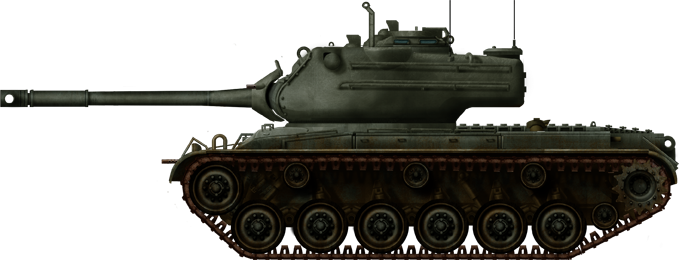
For comparison, the M47 Patton.
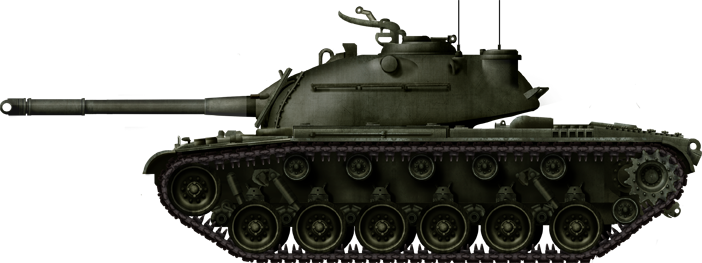
Early test model T48 at Detroit tank arsenal, 1953.
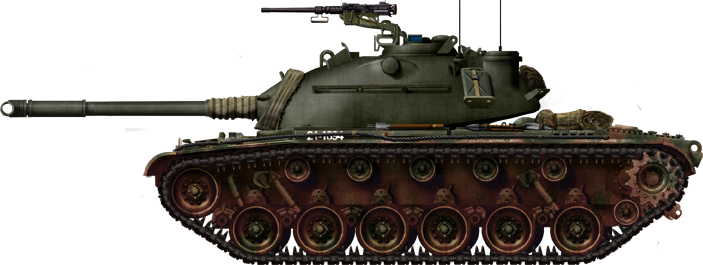
M48 Patton, first production in exercizes, 1955.

40th armored brigade, 4th armored regiment, 2nd batallion, A company, Royal Jordanian Army, Jenin sector, western bank sector, 1967 (six days war).

Pakistani M48, 5th armored division, 25th cavalry, 6th squadron, Sialkot sector, 1965 (Indo-Pak war).
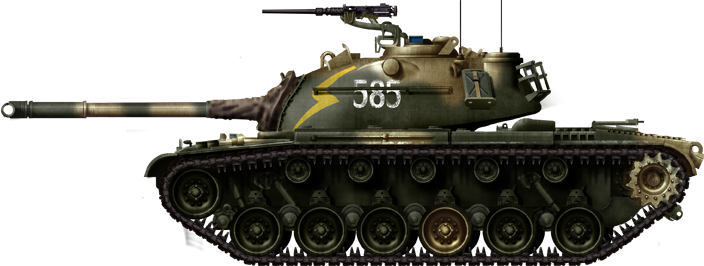
South Korean M48 Patton, Seoul defence area, 1970.

M48A1 Patton, A company, 37th armored regiment, 4th armored division, Neukirchen, Exercize Wintershield III, february 1961.
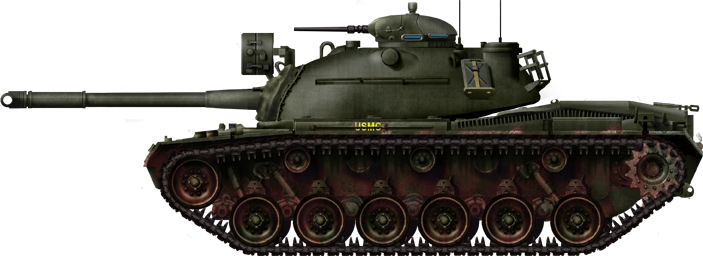
M48A2 from the USMC in Viet-Nam, 1966.
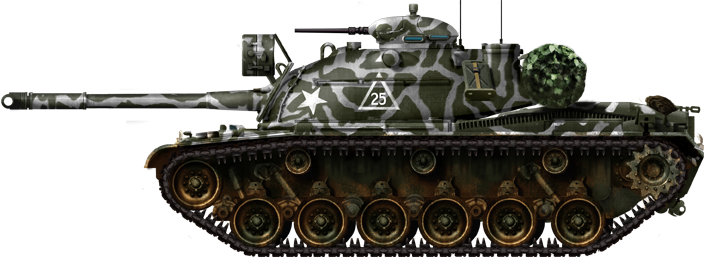
M48A2C from the Company A, 3rd Med 40th armor battalion, US 1st Cavalry, South Korea, 1962.
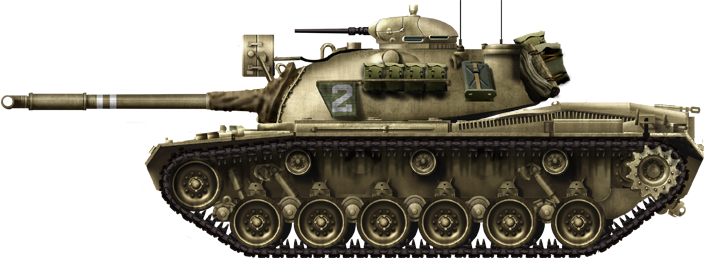
Israeli, M48A2C Ugdo Tal 7th armoured brigade, 79th tank batallion, sinaï, 1967.
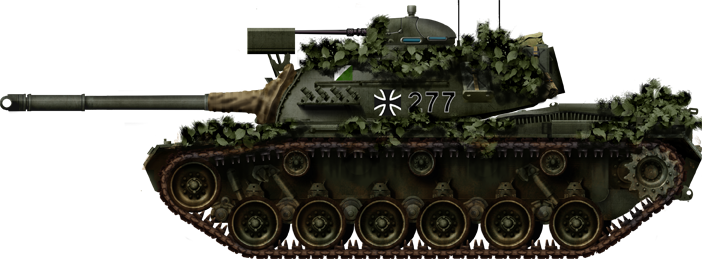
M48A2C Bundeswehr, 35th Armoured Brigade, 12th Panzerdivision, (“Orange Force”), Exercize “Certain Thrust” part of Reforger III, october 1970.
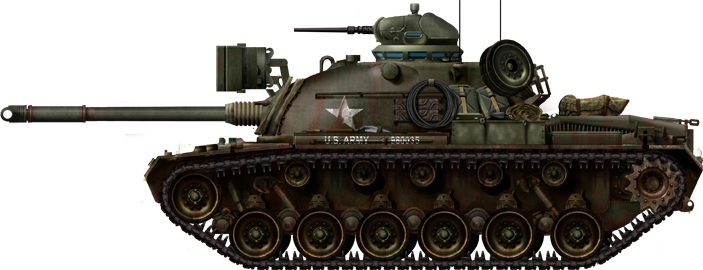
M48A3, possibly from the 1st tank batallion, Viet-Nam, 1966.
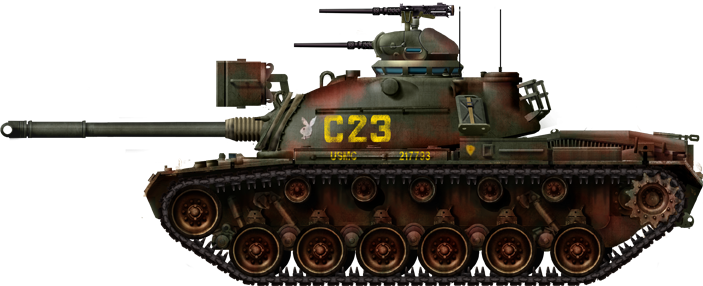
M48A3 “Playboy Bunny”, C Company, 2nd Platoon, 3rd Tank Battalion, 3rd Marine Division, South Vietnam, 1968.
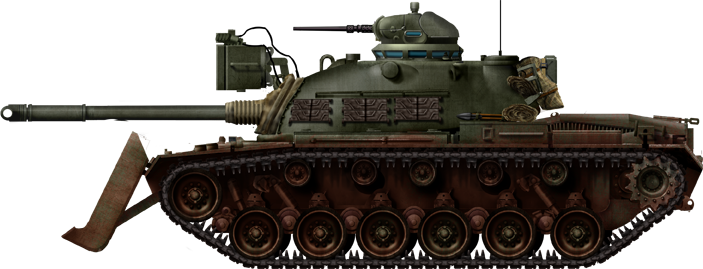
M48A3/E8 Tear Gaz launcher & Dozer, 1st Infantry, Phuoc Minh, Viet-Nam 1969.
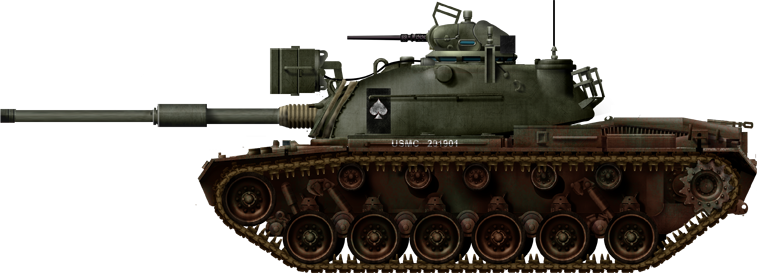
M48A3 from an unknown cavalry division, Viet-Nam 1971.

Israeli E8 M48A4, Yom Kippour 1973.

Late M48A5 Patton (with Urdan cupola) of the US 50th armoured division, 1982.
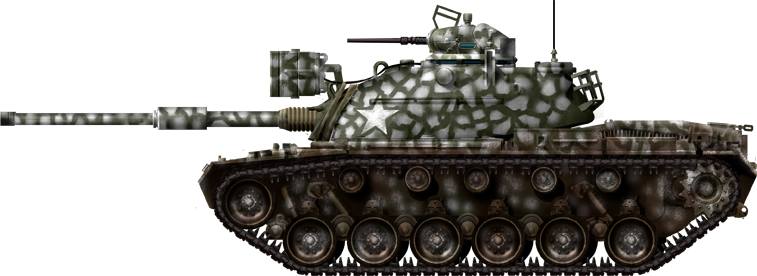
U.S. M48A5 stationed in West Germany in winter exercises, 1980s.
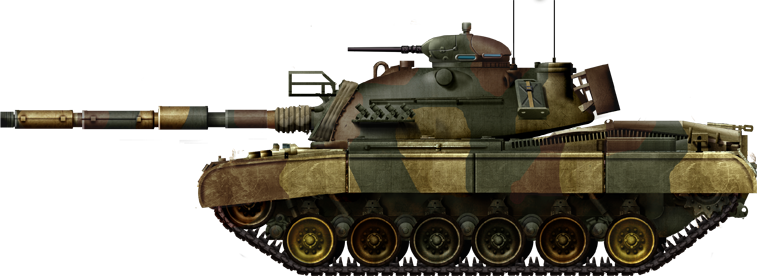
Turkish M48 T5, 1985.

M48A2GA2 with G305 Riser (M1 cupola) and laser designator, Bundeswhehr, 1985.
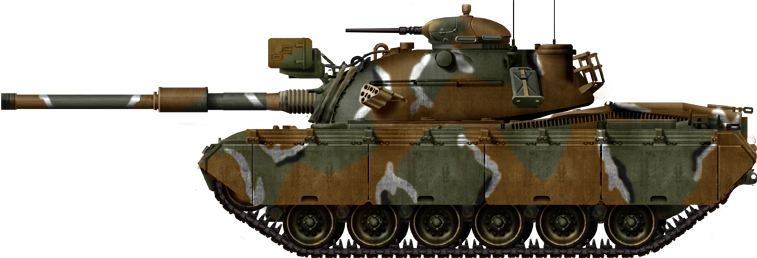
South Korean Army M48A5K, 1980s.
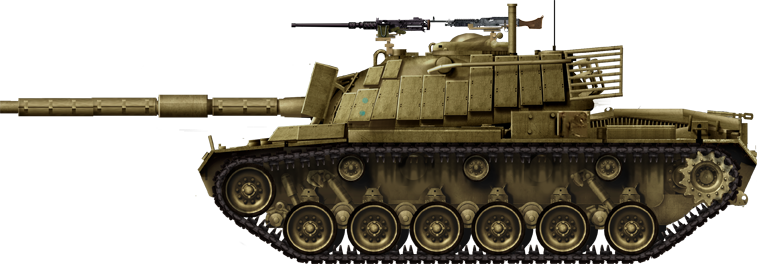
Israeli Magach 5 Golan. World first to be equipped with ERA blocks in operation, “Peace in Galilee”, Lebanon june 1982.

M48A5E1, US Army, Fort Benning, Columbus, Georgia, 1995.

Cold War Tanks


































Cold war tanks posters

Cold War Main Battle Tanks

Cold War Soviet Army
Museums, Movies, Books & Games
The Tanks and Armor in pop culture
Tanks and armored vehicles in general are only really grasped when seen first person: The mass, the scale, it's all there. Explore also the way tanks were covered in the movie industry, in books and in video games.Movies:
Best tanks movie on warhistoryonline.com
On imdb.com
On bestsimilar.com/
miltours.com
liveabout.com/
watchmojo.com
Video Games:
pcgamesn.com
historyhit.com
levvvel.com
vg247.com/best-tank-games
mmobomb.com/
alienwarearena.com


















